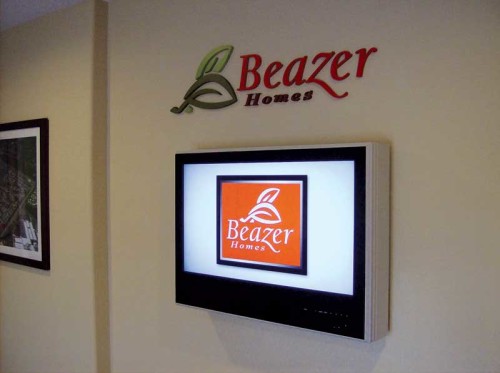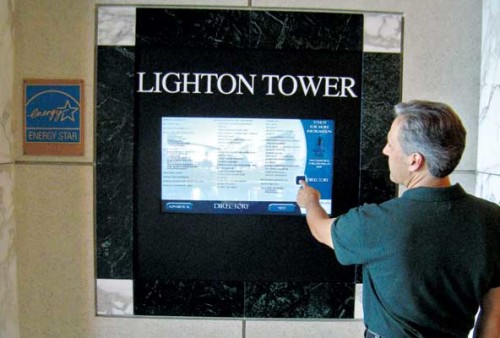Content management tactics
It is important to establish upfront who will create content to drive the digital signage network. Given it can be expensive to outsource this task to a marketing agency, the following 10 tactics can help make the most out of existing resources.
1. Use templates.
Most of today’s digital signage systems offer built-in templates that can be used readily with only minor tweaks. These tools greatly reduce the time and complexity involved in creating and maintaining content. They can be repurposed to accommodate all types of information, from meals on a restaurant menu to scheduled events for a conference centre. And they can be used over and over again.
2. Tune into TV.
It may seem counterintuitive at first, especially in corporate environments, but supplementing digital signage content with TV programming is a proven method for attracting more attention. It also relieves much of the burden of constantly creating fresh content. Some digital signage systems offer optional TV tuners and are designed to incorporate TV shows within their screen layout. There are a few caveats to keep in mind, including (a) the requirement to pay commercial licensing fees to retransmit TV content and (b) the difficulty of competitive conflict, e.g. when a digital sign in a car dealership ends up displaying ads for its competitors.
3. Subscribe to syndication.
As mentioned, syndicated digital signage content services can be very useful. And rather than seek a broad range of news, network managers can choose feeds representing compatible areas of interest, so as to make the content more relevant in the eyes of the viewers.
4. Stream video.
Many of today’s digital signage systems also make it easy to integrate streaming video from a webcam. A retailer at a ski resort, for example, might stream scenic views from a mountaintop lodge. At an airport, passengers may appreciate control tower views of takeoffs and landings. The main benefit is fresh, dynamic content without having to devote personnel to creating it.

In a corporate setting, digital signage might be deployed in a lobby to welcome visitors or add to the ambience.
5. Import data.
Similarly, if content can be automatically imported from databases and other sources, staff is relieved from having to reformat or retype it for the screen. Tapping into data automation is an efficient way to repurpose existing resources without needing to hire a full-time content manager, graphics artist or other service provider. Widgets and other software can also be used to source news feeds, social media and corporate updates. It is simply a matter of starting out by identifying which data could populate which template fields.
6. Offer internships.
If a marketing manager can invest some quality time to mentor a student, digital signage content creation can be a great opportunity for a graphic arts student from a local community college, university or institute, whose programs are filled with participants looking for a chance to let their talents shine. This can be a real win-win scenario.
7. Choose the right software.
Digital signage software runs the gamut from easy-to-use to poorly designed user interfaces (UIs). Managers with little time to devote to digital content creation should carefully evaluate a content management system (CMS) before purchasing it, including the level of support offered by the developer.
8. Repurpose non-digital assets.
In addition to databases, most businesses also have access to existing analogue material—such as flyers, brochures, sell sheets and catalogues—that can be turned into digital signage content. Again, graphic arts interns or departments can be highly beneficial in reworking these resources to fulfil the specific requirements of the medium.
9. Repurpose other digital assets.
For that matter, a lot of existing digital content—such as corporate videos, presentations and branding—can be reused on screens if appropriate. The marketing department may be a rich source of valuable assets.
10. Use RSS feeds.
Really Simple Syndication (RSS) feeds from the Internet can be used to constantly update a screen with fresh content. In many cases, digital signage software is designed to support them as data sources. They can even be directed from the business’ own website, so as to reinforce corporate messaging, but there are also countless local and national feeds on various topics that could supplement the core communications strategy.

Touch screens engage passersby on a more personal level, even in a public space.
Engaging through interactivity
To be successful, marketers must present their messages in a context that enhances their value
to customers. A billboard, for example, might let highway drivers know about a restaurant or gas station at the next exit.
To this end, digital signage content must in some way capture the attention of viewers and then focus it on product features, information and/or entertainment that adds to the marketer’s branding efforts. For digital signage to be effective in a retail setting, for instance, the content needs to help make the shopping experience better than it would be without digital signage. One way to do so is to allow customers to interact with and/or change the content.
“The majority of truly successful and innovative media campaigns involve an element of spontaneity, whether it’s copy that can be adapted dynamically based on real-time data or an interactive component that allows the consumer to get involved,” said Sophie Burke, head of marketing for Zoom Media in the U.K., in an interview for a recent article by Geny Calosi for Output magazine.
“If you touch a screen, you are engaging on a more personal level, even if in a public space,” said Nick Mawditt, global director of insight and marketing for Kinetic, in the same article.
In the same way content on the Internet benefits by offering relevant interaction with users, so too can digital signage create a more helpful experience for viewers by adding interactivity. And with today’s mainstream availability and acceptance of touch screens, such consumer engagement does not necessarily need a huge budget.
Planning screen placement
Digital signage placement matters too, of course. No one will look up to a ceiling for announcements. Rather, product-specific content should be displayed at eye level close to the products in question. The closer the advertising is to the opportunity for a purchase, the more effective it will be.
By placing screens of optimal size in the best locations, the stage is set for creating content that stimulates viewers, influences their behaviour, reinforces branding and complements the surrounding environment.
Uniquely creative
While trial and error have helped many organizations become successful with digital signage, it is important to shake off the still-common notion that a ‘slide show’ is sufficient to engage viewers. The marketing strategy needs to be more creative.
With this in mind, full-service digital signage providers have a strong opportunity to help businesses design their campaigns. Through a discovery process, they can help determine what that organization’s ‘wow’ factor is, i.e. what is unique about it, and also research the audience to understand what it cares about. And once a successful call to action has been delivered on-screen, they can measure results with relation to return on investment (ROI) and return on objectives (ROO).
David Little is marketing consultant for Keywest Technology, which develops digital signage software and hardware. For more information, contact him via e-mail at davidl@keywesttechnology.com.





